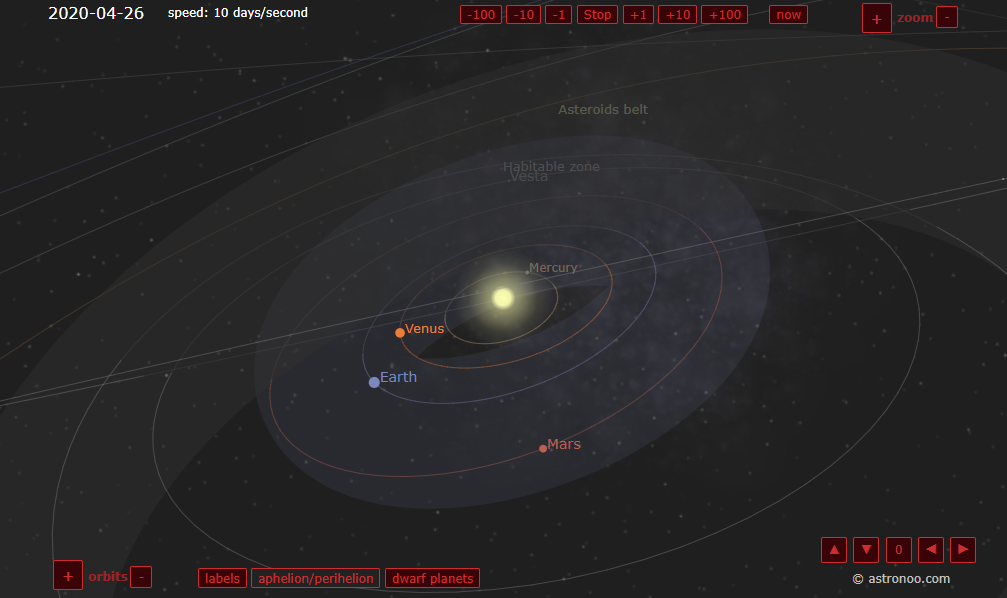用.NET模拟天体运动
这将是一篇罕见而偏极客的文章。
我上大学时就见过一些模拟太阳系等天体运动的软件和网站,觉得非常酷炫,比如这个(http://www.astronoo.com/en/articles/positions-of-the-planets.html):

其酷炫之处不仅在于天体运动轨迹能画出美妙的弧线,更重要的是其运动规律完全由万有引力定律产生,不需要对其运动轨迹进行编程。所有天体受其它天体的合力,然后按照其加速度运行。只需一个起始坐标和起始速度,就能坐下来欣赏画面。
我从大学毕业后就一直对这个抱有深厚兴趣,工作第一年时我就用C++做过一版;后来我负责公司前端工作,又用js/canvas又做了一个重制版;由于近期爆发的.NET“革命”,我近期又用C#/.NET再次重制了一版。
需要的数学知识
由于是程序看数学知识,此处我将使用代码来表示公式。
- 万有引力,该力
F与两个天体的质量m1,m2成正比,如距离r的平方成反比,用代码表示为:F = m1 * m2 * G / r ^ 2; - 牛顿第二定律,加速度
a等于合力F除以质量m,用代码表示为:a = F / m; - 速度
v与加速度a以及时间t的关系,用代码表示为:v = a * t; - 距离
s与速度v以及时间t的关系,用代码表示为:s = v * t。
这里面的所有知识都已经在高中物理提过了,但有两点需要注意:
- 所有的力、加速度、速度以及距离都需要分为
x轴和y轴两个分量; - 所有的时间
t实际上是小段时间dt,程序将循环模拟小段时间累加起来,来模拟天体运动。
核心代码
天体类:
class Star
{
public LinkedList<Vector2> PositionTrack = new LinkedList<SharpDX.Vector2>();
public double Px, Py, Vx, Vy;
public double Mass;
public float Size => (float)Math.Log(Mass) * 2;
public Color Color = Color.Black;
public void Move(double step)
{
Px += Vx * step;
Py += Vy * step;
PositionTrack.AddFirst(new Vector2((float)Px, (float)Py));
if (PositionTrack.Count > 1000)
{
PositionTrack.RemoveLast();
}
}
}注意,我没指定大小Size,直接给值为其质量的对数乘2,另外注意我使用了一个PositionTrack的链表来存储其运动轨迹。
万有引力、加速度、速度计算
void Step()
{
foreach (var s1 in Stars)
{
// star velocity
// F = G * m1 * m2 / r^2
// F has a direction:
double Fdx = 0;
double Fdy = 0;
const double Gm1 = 100.0f; // G*s1.m
var ttm = StepDt * StepDt; // t*t/s1.m
foreach (var s2 in Stars)
{
if (s1 == s2) continue;
var rx = s2.Px - s1.Px;
var ry = s2.Py - s1.Py;
var rr = rx * rx + ry * ry;
var r = Math.Sqrt(rr);
var f = Gm1 * s2.Mass / rr;
var fdx = f * rx / r;
var fdy = f * ry / r;
Fdx += fdx;
Fdy += fdy;
}
// Ft = ma -> a = Ft/m
// v = at -> v = Ftt/m
var dvx = Fdx * ttm;
var dvy = Fdy * ttm;
s1.Vx += dvx;
s1.Vy += dvy;
}
foreach (var star in Stars)
{
star.Move(StepDt);
}
}注意其中有个foreach循环,它将一一计算每个天体对某天体的力,然后通过累加的方式求出合力,最后依照合力计算加速度和速度。如果使用gmp等高精度计算库,该循环将存在性能热点,因此可以将这个foreach改成Parallel.For加lock的方式修改合力Fdx和Fdy,可以提高性能(C++的代码就是这样写的)。
绘图代码
public void Draw(DeviceContext ctx)
{
ctx.Clear(Color.DarkGray);
using var solidBrash = new SolidColorBrush(ctx, Color.White);
float allHeight = ctx.Size.Height;
float allWidth = ctx.Size.Width;
float scale = allHeight / 100.0f;
foreach (var star in Stars)
{
using var radialBrush = new RadialGradientBrush(ctx, new RadialGradientBrushProperties
{
Center = Vector2.Zero,
RadiusX = 1.0f,
RadiusY = 1.0f,
}, new SharpDX.Direct2D1.GradientStopCollection(ctx, new[]
{
new GradientStop{ Color = Color.White, Position = 0f},
new GradientStop{ Color = star.Color, Position = 1.0f},
}));
ctx.Transform =
Matrix3x2.Scaling(star.Size) *
Matrix3x2.Translation(((float)star.Px + 50) * scale + (allWidth - allHeight) / 2, ((float)star.Py + 50) * scale);
ctx.FillEllipse(new Ellipse(Vector2.Zero, 1, 1), radialBrush);
ctx.Transform =
Matrix3x2.Translation(allHeight / 2 + (allWidth - allHeight) / 2, allHeight / 2);
foreach (var line in star.PositionTrack.Zip(star.PositionTrack.Skip(1)))
{
ctx.DrawLine(line.First * scale, line.Second * scale, solidBrash, 1.0f);
}
}
ctx.Transform = Matrix3x2.Identity;
}注意我在绘图代码逻辑中做了一些矩阵变换,我把所有逻辑做成了窗体分辨率无关的,假定屏幕长和宽的较小值为100,然后左上角坐标为-50, -50,右下角坐标为50, 50。
星系模拟
太阳、地球和月亮
这是最容易想到了,地球绕太阳转,月亮绕地球转,创建代码如下:
public static StarSystem CreateSolarEarthMoon()
{
var solar = new Star
{
Px = 0, Py = 0,
Vx = 0.6, Vy = 0,
Mass = 1000,
Color = Color.Red,
};
// Earth
var earth = new Star
{
Px = 0, Py = -41,
Vx = -5, Vy = 0,
Mass = 100,
Color = Color.Blue,
};
// Moon
var moon = new Star
{
Px = 0, Py = -45,
Vx = -10, Vy = 0,
Mass = 10,
};
return new StarSystem(new List<Star> { solar, earth, moon });
}注意所有数据都没使用真实数字模拟(不然地球绕太阳转一圈需要365天才能看完
相关文章
- .Net Core使用分布式缓存Redis:数据结构
- .net core 3.1简体中文语言包,英文只能提示变成中文!
- AI Boot Camp 分享之 ML.NET 机器学习指南
- 【广州.NET社区推荐】【译】Visual Studio 2019 中 WP
- 使用.NET Core创建Windows服务 - 使用.NET Core工作器
- 鲲鹏来了,在EulerOS试用.NETCore-3.1
- 如何在ASP.NET Core 中快速构建PDF文档
- [ASP.NET Core 3框架揭秘] 配置[5]:配置数据与数据源的
- 使用ASP.NET Core 3.x 构建 RESTful API - 3.3 状态码
- Linux下基于Docker部署.Net Core web api项目
- F#周报2019年第50期


